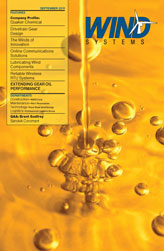Tell us about your role in representing Sandvik Coromant to the U.S. wind industry.
For the past couple of years my responsibilities have involved focusing on our customers in the United States who machine components of all types for the wind industry. I travel around the country visiting these companies and asking about the toughest machining challenges they face so that we can help provide a solution. I will listen carefully, learning everything I can about their particular application, and then I can suggest a standard or modified tool from one of our product platforms. At the same time I’m able to take that information back to our design engineers and develop a custom tool that perfectly matches the customer’s requirements. Sandvik Coromant has been designing and manufacturing metal-cutting tools for nearly 150 years, and we’re the world’s leading producer of tools for turning, milling, and drilling, so we possess a wealth of knowledge and experience to share with the wind industry.
Can you give us examples of solutions you’ve provided to your wind customers?
Think of the hub of a wind turbine. It’s a huge rounded component that typically has three holes that the blades pass through. The diameter tolerances on those holes are very tight, and it needs an extremely smooth surface finish as well. These hubs are cast, and when they arrive at a machine shop the holes are generally pretty rough and the whole component is covered with scales. One of our customers was having a really hard time coming up with an efficient way to finish machine these holes, so we developed a customized version of our CoroBore tool that ended up being more than five feet in diameter. The tool worked perfectly for the customer, which saved them a ton of cycle time and allowed them to produce more hubs than ever before.
Along the same lines, many wind components are extremely large, and it’s very time consuming to move them around to work on different areas when they’re mounted on a machine. We met with another customer who explained that what they needed was a longer tool that would allow them to reach into tight spaces to machine features on components without having to reposition them so often. The problem, though, is that if you simply lengthen the shank of a standard tool you’ll get a great deal of vibration, which makes it impossible to get a good cut or finish. The length to diameter ratio on some of these tools approaches 10:1, and sometimes even 14:1. That’s where our anti-vibration “silent tools” come in. These are milling, turning, and even boring tools with a dampening device mounted inside the shank, which allows the tool to be extended deep into a component and perform its machining function with no vibration. This feature in particular has really been a godsend for our wind customers, increasing both productivity and the quality of the finished component.
Match up some of your products with the wind components they’re used to manufacture.
If you’re manufacturing connecting rings you’d be interested in the CoroDrill 880, which basically doubles your drilling speed, and T-MAX P negative roughing inserts for the turning operations. For hubs you could also use the CoroDrill 880 along with the CoroMill 390 for shoulder milling, the CoroMill 331 for back facing, and the CoroMill 345 for face milling. Products like our roughing disc cutters, CoroCut grooving system, CoroTurn products, and new-generation carbide grades are perfect for the production of the slewing rings. For the turning operations use T-MAX P roughing inserts and then finish turn with our Wiper inserts. The CoroDrill is great for drilling holes in the flange of the main shaft. Just about everything I’ve mentioned can be used to manufacture parts like the main frame, gearbox housing, and torque arm.
We also have a wide selection of cutting tools, inserts, and accessories for producing gearboxes, shafts, ring gears, planetary carriers, and the foundation of all our tooling systems is the Coromant Capto coupling. As important as these tools are, however, they’re really only part of the package we offer. The rest consists of the knowledge we have to share with our customers, because their success is necessary in order for us to achieve our own goals. And it’s been my experience that the manufacturing companies that are partnering with Sandvik Coromant are producing more components, more quickly, and at a higher level of quality than their competitors. I am extremely confident when I meet with our customers, because I know that we can back up everything we say.
To learn more: Call (800) SANDVIK (726-3845) or visit www.sandvik.coromant.com/us/wind.








































